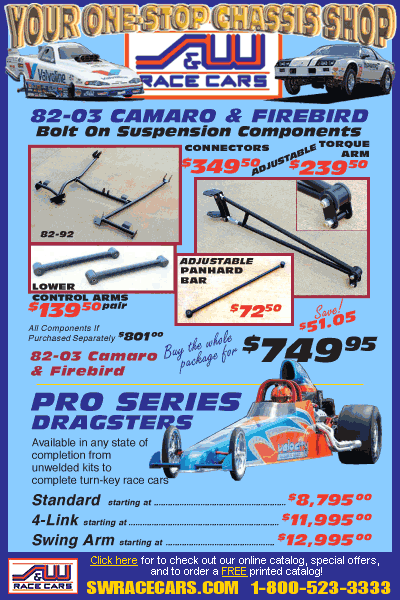| 
ADVERTISEMENT

|
The impact of the Comets arrival in '66 would be hard to
overstate as during an era of modified stock frames and steel
bodies with a few glass/alum body parts, the Comets were tube
frame/fliptop all glass bodies and they were built to be racecars
starting with a clean sheet of paper. The average blown FC
of the day weighed about 3000-3200 lbs. and the Comets were
under 1800 lbs.
I was with Beswick at the time and one look told us we were
in serious doo doo with a 3200 lb., GTO blower or not. In
fact all the blown cars had the same problem. Naturally we
knew we needed the same tube frame/all glass body but with
a blown motor, but it was a year (1967) before anyone did
that. In the mean time we pulled Arnie’s '63 Tempest
out of storage and started to build the lightest car possible
with what we had to work with and were able to get it down
about 600 lbs. from the GTO.
The tracks were calling every day wanting the GTO to match
race with Nicholson and we were putting them off as we knew
we had nothing for the Comets at that time. The Mr. Norm team
took about the same approach as they bought a USED (the factory
did not want a supercharged engine in their cars) factory
injected car with the titanium K-member and light fender/doors/etc.
and installed the blown motor from the old car.
Both the Nicholson (Earl Wade) and Schartman’s (Amos
Satterlee) Comets were killing everyone on a weekly basis.
Arnie had hired me from Mr. Norm’s with the promise
of driving the second car, so I had been squirreling away
parts for “MY” motor for months.
One of the more serious problems of running a supercharged
Pontiac on nitro was the lack of available parts; we had been
running more compression and less Nitro than I wanted because
of the pistons we were forced to use. We got our new custom
ForgedTrue low compression nitro pistons and I had our new
high percent Nitro motor ready for the GTO as we were going
to run our “standard” motor in the Tempest to
start out with a proven combination.
Arnie got a call from a track in Nashville who offered him
huge money to come and run Nicholson’s Comet. I will
let you guess where “MY” motor went. I don’t
believe Nicholson had lost a race with the new Comet until
that Friday night when we beat him fair and square three straight,
proving the independent blown cars could run with the Comets
IF you got light enough.
I can recall at least two other times during that year ('66)
we were able to take a modified Pontiac Tempest car with a
real Pontiac motor and beat the best the factories had, but
it was clear were this was headed—tube frame/all glass
bodies, still a year away for the Independents.
The Sunday following our Friday night match up with Dyno
Don, I drove the GTO against a new FC team from Chicago who
at the time had an altered wheelbase car sponsored by Sedlak
Plymouth. The following year ('67) this group would field
a new car with a catchy name “The Chi-town Hustler”
soon reached near immortal status as the “Father”
of the 1000 foot smokey burnout. One of the crew has gone
on to do well as a crew chief, don’t you think??
By the following year ('67) I was with Bill Taylor and his
“Kingfish Barracuda.” This was a “killer”
car from the start, as I believe this was one of the first
nitro FCs to have all the pieces of the Funny Car puzzle together
at one time--tube frame, fliptop glass body and a 426 Hemi
blown on nitro. Taylor sold this car after a very short time
but the performance of this car during the short time we ran
it is what FORCED the factory cars to go to blowers.
I went to work for Nicholson ('68/'69) during the next big
change as the factory cars went to blowers. This was the SOHC
era for a couple of years, with Nicholson winning Indy in
'68 in whatever they were calling the class that year and
the Mickey Thompson/ Ongais/ Satterlee Mustang winning Indy
in '69 in the new stand-alone Nitro Funny Car class.
The Pat Foster-built M/T Mustangs were another change and
were the first of the narrow chassis/dragster roll cage/Zoomie
header type cars. By mid-1971 the “hot setup”
was the narrow chassis and body---Crowerglide clutch---Lenco
or B&J 2 speed---butterfly steering wheel and a hand brake
not too different from today.
From that time on the Nitro FC history I have read is pretty
accurate so I won’t repeat what you have read other
places.
The “Glory Years” of Nitro FC match racing was
really in two parts as from 1965-1968 there was no Nitro FC
class at major events. During this time their were at least
30 cars running 30 dates per year, three runs per date—that’s
2700 runs per year for several years. There were NO RULES/NO
LICENSE/NO TECH and no need.
From 1969 to say 1982 you did need to have a Nitro License
and meet some safety rules but on the match race circuit there
were NO RULES for engine size, weight, blower size/overdrive,
nitro percent, gear ratio or anything else for that matter.
How could we have had thousands and thousands of runs and
the BEST NITRO FC RACING OF ALL TIME under these conditions
you ask? Hey, maybe we have too many rules now, just a thought
from someone who started racing Nitro in 1958 and made a living
at it for over 30 years.
Stay tuned for Part 3!
|
